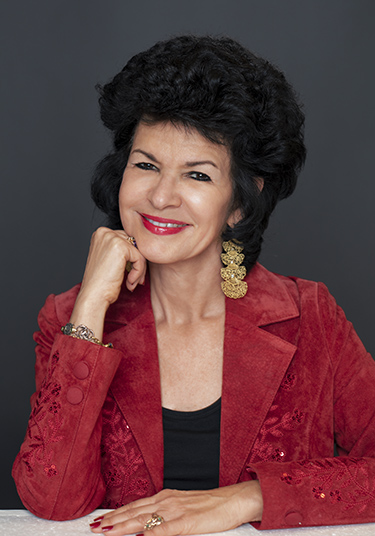Discoveries
Style and Substance: Rita Shane, PharmD
Feb 20, 2019 Cassie Tomlin
Cedars-Sinai’s chief pharmacy officer—accomplished patient advocate, and fashion icon—on 40-plus years in the field.

Photo: Al Cuizon
Rita Shane, PharmD, is always looking for opportunities: career advancement for students and staff, system improvements for safer medication management, a sale on green suede slingback pumps.
Shane’s tenacious commitment to her field spurred her to help close a gap in the way California hospitals protect patients from dangerous medication errors. Aware that hospitals didn’t assign specific clinicians responsibility for collecting and maintaining patients’ medication lists, she saw an opening for pharmacists to take the lead. In 2018, she drafted legislation (which has since become law) requiring hospital pharmacists throughout the state to update medication lists for high-risk patients when they are admitted. (Cedars-Sinai defines a high-risk patient as one who takes 10 or more medications or is undergoing organ transplantation.)
Here, Shane discusses how she wrote the bill (while nursing a cold with help from cognac on New Year’s Eve) and what’s changed over her 40 years in clinical pharmacy.
Q. Why is this law so important?
A: My colleague Joshua Pevnick, MD, and I found that high-risk patients arrive with an average of eight errors on their medication lists when they’re admitted, which puts them at risk for severe adverse reactions in the hospital. Medications are entered into patients’ electronic health records by many people who aren’t necessarily experts in drugs: staff at doctors’ offices, skilled nursing facilities, and hospitals. We found that when pharmacy staff obtained medication lists, there was an 80 percent reduction in medication history error.
Q. How was your experience drafting this bill?
A: I got connected with State Senator Jeff Stone, who is also a pharmacist, because I’d been working for three years with the California Hospital Association to improve the process for obtaining medication histories in hospitals. I met with Senator Stone about the bill six days before Christmas in 2017. The bill passed unanimously through the legislature, and Governor Jerry Brown signed it into law in September 2018. I’m politically agnostic, but halfway through the process, I realized politics was in the middle of this: Senator Stone is a Republican; Governor Brown is a Democrat. In the end, fact-based argument for patient safety won. That’s rewarding.
Q. What inspired your focus on transitions of care?
A: Everyone has a story about something that’s gone wrong with medications. For me, the passion really started after an experience with my dad 20 years ago. He was hospitalized for a brain surgery and, when he was transferred to another facility, they inadvertently took him off an important drug. The change in medication agitated him, so he ended up in restraints and developed a serious infection. Had his medication history been done correctly, this wouldn’t have happened. I thought, “We’ve got to fix this problem; this is a mess.”
Q. You’re known for your style as well as your leadership. What does that mean to you?
A: I think it’s important to balance being a professional with being an individual. I inherited my so-called flashy style from my parents; my mother and her sisters were dressmakers, my father was a clotheshorse, and we used to shop together on weekends to de-stress. Every time I travel internationally for speaking engagements, I trip over something to shop for. I just brought back four pairs of boots from pop-up markets in Spain.
In the blog: Ask a Pharmacist: Cedars-Sinai's Rita Shane
Q. Have you experienced pushback for how you present yourself?
A: When I became director of Pharmacy Services, my boss suggested I bring in consultants to evaluate the department structure and processes. I invited two nationally respected pharmacy leaders, nice gentlemen who met with pharmacy staff, physicians, and nurses. On the last day, they asked to speak with me confidentially and suggested I tone down the way I dressed. I realized their comments had more to do with them and less to do with me, and I didn’t really let it change me. They’ve both since apologized for commenting at all and stated that they respected my individuality. My best advice for women is advice from my mother: Be an individual, and don’t accept “no” when you believe in something.
Q. What is your teaching philosophy?
A: I’ve mentored more than 120 pharmacy residents. I love to teach. We’ve taught pharmacy students, residents, technicians, and interns to obtain medication lists from patients so they learn from real experience. What better opportunity for students to immerse themselves in the profession than to greet a patient upon arrival and review their history with them, knowing the context of the medications? In that brief encounter, they’re representing every pharmacist as someone who cares about patients and wants to make sure they’re safe. At the same time, they’re learning about drugs and how to engage with patients to make them more comfortable.
Rita Shane, PharmD
Chief Pharmacy Officer Professor, Department of Medicine Assistant Dean of Clinical Pharmacy Services, University of California, San Francisco School of Pharmacy
Close to Home
Shane was born in Los Angeles, graduated from Fairfax High School, obtained her undergraduate degree at UCLA and her doctorate at USC, and started as an intern at Cedars-Sinai in 1978. She stayed close to home, she says, to be near her parents, who were both Holocaust survivors.
Stats
In more than four decades at Cedars-Sinai, Shane has authored 100 papers and presented at more than 200 meetings. She is a recipient of the American Society of Health-System Pharmacists Harvey A. K. Whitney Award.
Personal Motto
“Act like a nerd, look like a princess.”
Family
Shane and her husband, Jeffrey Gramer, MD, have two adult children, Elizabeth and Benjamin, and one grandson, Liam Jude. “They’ve made me human,” she says of her offspring. “They teach me to recognize and respect differences in people and remind me to be present.”

